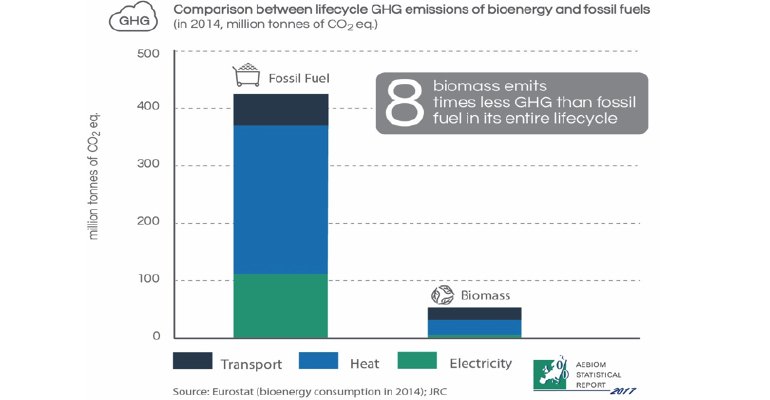A week before the European Parliament’s vote on REDII, the debate on solid bioenergy’s role and future contribution to meeting the EU’s renewable energy targets has yet again been taken hostage by radical statements from a select few NGOs. While catchy headlines, petitions and non-peer-reviewed studies might make for an effective communication strategy, official statistics from Eurostat tell another story — one much closer to the sectoral reality says Jean-Marc Jossart, Secretary-General AEBIOM.
Over the past 25 years, the stock of EU forest has increased by 7.3 billion m³, whereas the stock of available wood supply has grown by more than 5 billion m³. Only about 63 percent of the annual increment is used even though the amount of bioenergy consumed during the last 15 years has doubled.

This is because Europe’s forests are not managed exclusively for energy purposes, but rather supply a wide range of industries. Forests that are well-managed, therefore, encourage future growth and the sequestration and storage of more carbon. Public policies encouraging renewables have not drastically increased the share of wood removals going to the energy sector, its share of approximately 20 percent has remained quite stable since 2000.
Bioenergy is the largest renewable energy source, representing over 60 percent of the total renewable energy consumption in the EU-28. Over the past decades, bioenergy has significantly contributed to the decarbonisation of the EU’s energy sector by replacing fossil fuels.
If fossil fuels were used in the heating, electricity and transport sectors instead of the share provided by bioenergy, the EU would have emitted an additional 4 200 million tonnes of greenhouse gases (GHG) over the last 15 years, according to JRC methodology.

In 2014 alone, the EU prevented the emissions of an additional 365 million tonnes of carbon dioxide (CO2) equivalent, thanks to bioenergy. This is more than the total annual emissions of Spain over that same year.
Unlike the irreversible, linear nature of emissions from fossil fuels, carbon released during the combustion of biomass is part of a loop. Trees that are used for biomass have spent a lifetime growing to store carbon. Those that are planted, or regrow naturally to replace them, begin that process again.

Although in this atmospheric carbon cycle time is needed for the tree to grow back and recapture the CO2 emitted, this timeframe ranges from years to decades, and not from decades to centuries, as is sometimes claimed. The carbon stock in the EU-28’s forests keeps on increasing thanks to sustainable forestry management and reforestation programmes in Europe.
High-value timber is not used for bioenergy. The European bioenergy sector has developed hand in hand with other wood-based industries to give value to low-value materials such as sawdust, mill residues, thinnings, low-quality wood, tops and limbs that otherwise would not have been used. Bioenergy users simply cannot afford to use the high-quality timber that is used by furniture manufacturers or the construction industry.
As an example, in Belgium during the winter season of 2016, the price of one cubic metre (m3) of lumber grade timber was EUR 100-120 which is almost ten times higher than the price of one m3 of wood for energy, EUR 6-13. Bioenergy players are not able to match the prices offered by the wood processing industry. Based on this price index, using Belgian lumber grade timber to produce 1 MWh of electricity would range between EUR 833-1 000. This equates to a price ten times higher than the average cost of electricity in Belgium, EUR 108-235 per MWh.
Claiming that the development of solid bioenergy in Europe encourages deforestation in countries such as Indonesia and Brazil is incorrect. The imports of bioenergy are stable and limited. In 2015, bioenergy represented only 1 percent of all imported fuels.

EU-28 bioenergy import dependency is 4.4 percent, a tiny fraction compared to that of fossil fuels for which dependency ratios reach 89 percent for oil and 69 percent for gas respectively. The EU therefore primarily relies on local resources, effectively reducing its energy dependency thanks to wood fuel. Moreover, the vast majority of the imported fraction of solid biomass is sourced from North American forests.
As in any other sector, there is no doubt that poor practices need to be addressed. Bioenergy must develop within a sustainable framework, which is why for many years AEBIOM has called for the introduction of EU sustainability criteria for all bioenergy.
Sensationalising the debate on how best to define and implement these criteria discredits the honest work of hundreds of thousands of foresters and project developers working tirelessly to accelerate the energy transition in a sector populated primarily by small- and medium-sized enterprises (SMEs).
Limiting the development of Europe’s largest source of renewable energy is a dangerous game, as in many cases bioenergy represents the best option to lead the energy transition. Without it, it is hard to see how we could ever meet our renewables and decarbonisation targets. Bioenergy is no plan B.



